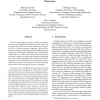Free Online Productivity Tools
i2Speak
i2Symbol
i2OCR
iTex2Img
iWeb2Print
iWeb2Shot
i2Type
iPdf2Split
iPdf2Merge
i2Bopomofo
i2Arabic
i2Style
i2Image
i2PDF
iLatex2Rtf
Sci2ools
113
click to vote
IPPS
2008
IEEE
2008
IEEE
Wait-free Programming for General Purpose Computations on Graphics Processors
The fact that graphics processors (GPUs) are today’s most powerful computational hardware for the dollar has motivated researchers to utilize the ubiquitous and powerful GPUs for general-purpose computing. Recent GPUs feature the single-program multiple-data (SPMD) multicore architecture instead of the single-instruction multiple-data (SIMD). However, unlike CPUs, GPUs devote their transistors mainly to data processing rather than data caching and flow control, and consequently most of the powerful GPUs with many cores do not support any synchronization mechanisms between their cores. This prevents GPUs from being deployed more widely for general-purpose computing. This paper aims at bridging the gap between the lack of synchronization mechanisms in recent GPU architectures and the need of synchronization mechanisms in parallel applications. Based on the intrinsic features of recent GPU architectures, we construct strong synchronization objects like wait-free and t-resilient read-m...
Distributed And Parallel Computing | GPUs | IPPS 2008 | Powerful Gpus | Synchronization Mechanisms |
Related Content
| Added | 31 May 2010 |
| Updated | 31 May 2010 |
| Type | Conference |
| Year | 2008 |
| Where | IPPS |
| Authors | Phuong Hoai Ha, Philippas Tsigas, Otto J. Anshus |
Comments (0)

